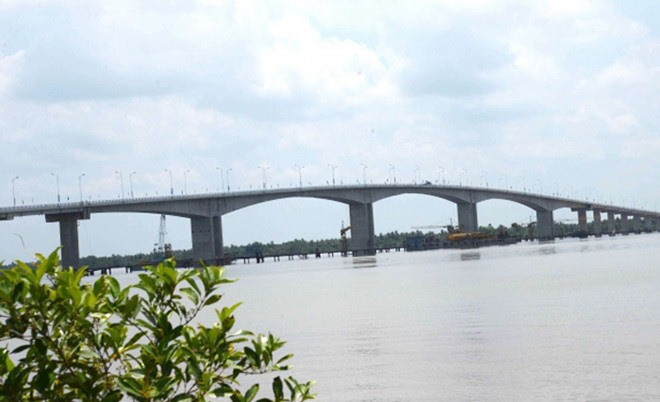 Co Chien Bridge between Ben Tre and Tra Vinh provinces in the Mekong Delta was built in 2015 (Photo: VNA)
Co Chien Bridge between Ben Tre and Tra Vinh provinces in the Mekong Delta was built in 2015 (Photo: VNA)HCM City (VNA) - Constructionof two bridges linking Cao Lanh city and Lap Vo district in Dong Thap provinceand Dong Thap with Can Tho city, which are under way, will be a big boost totransportation and connectivity in the Mekong Delta.
But locals can look forward to furtherdevelopment of the transport infrastructure in the near future.
The delta is blessed with road, inland waterway,marine and air transport facilities.
The infrastructure for road transport is basicallyin place though admittedly most roads could do with improvements.
The inland waterway and sea modes are notoptimally used yet since river and sea routes have not received adequateinvestment and a number of seaports have deposits of silt.
The delta has four airports, including twointernational facilities, which can meet the demand for air transport until2030.
According to the Ministry of Transport, 46transport projects, including 39 related to roads, have been taken up in theregion since 2010 at a total cost of 76.46 trillion VND (3.4 billion USD).
Almost half the money for them was raised byissuing State bonds while another 19 percent came from the Government’scoffers. The rest came from private sources, mainly in the form of BOT(build-operate-transfer) road projects.
The air transport infrastructure has beendeveloped by Vietnam Airlines and Vietnam Air Traffic Management Corporation.
A total 60.37 trillion VND has been invested inbuilding and upgrading 1,036km of roads and 60.2km of bridges.
The completed transport infrastructure in theregion includes the Can Tho, Ham Luong, Co Chien, My Loi and Nam Can bridges,the HCM City – Trung Luong and the Quang Lo - Phung Hiep Highways, and theSouth Hau River Road, all of which have helped improve connectivity between thedelta and HCM City.
According to experts, transportation in theregion still faces many challenges. The biggest challenge facing the Mekongtransportation infrastructure development is raising the huge amounts requiredfor major works like the HCM City – Can Tho Expressway.
It comprises two sections: one from the Trung LuongThree-road Intersection near HCM City to My Thuan Bridge in Vinh Long city, whichis expected to cost nearly 9 trillion VND (400 million USD), and the other fromMy Thuan to Can Tho costing nearly 7 trillion VND.
Being the most important infrastructure projectin the region, it will help connect the delta with HCM City, thus making theregion and its products competitive.
Son Minh Thang, deputy head of the SteeringCommittee for Southwest Region, said relevant agencies have been trying tomobilise investments for the project.
Authorities are also seeking to raise fundingfor a section of National Highway No 60 between National Highway No 1A (in SocTrang) and the HCM City – Can Tho Expressway, which would reduce the distancebetween HCM City and Ca Mau by 70km, helping the socio-economic development ofthe seven provinces in the eastern part of the delta, he said.
Priority in this project should be given tobuilding the Dai Ngai Bridge and Rach Mieu Bridge No 2, he added.
Vo Hung Dung, director of the Vietnam Chamber ofCommerce and Industry’s Can Tho Office, said only 1 percent of the investmentin infrastructure had gone into developing inland waterway transport, thestrong point of the region.
The money had mainly been spent on roads (79percent) and shipping (13 percent), he added.
He urged the ministry to reverse course if itwants to strengthen the delta’s transport infrastructure and better connect itwith other parts of the country.-VNA



























